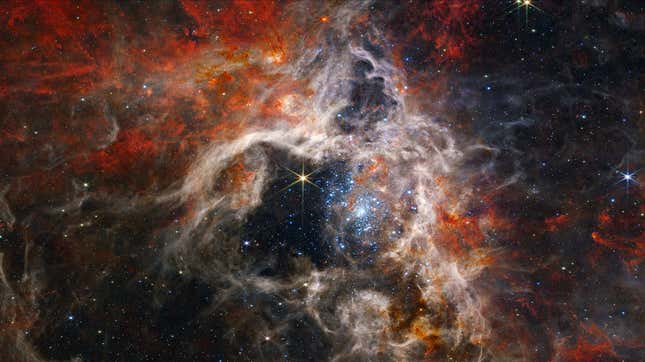
Isaac Schultz covers the general sciences for Gizmodo, with a focus on astronomy and astrophysics. You can follow his coverage here, and email story ideas and tips to isaac.schultz@gizmodo.com.
The top story:
The Webb Space Telescope will continue to dominate headlines in 2023. Its images of storied objects (like the Pillars of Creation) and never-before-seen objects (like Maisie’s Galaxy, one of the most distant light sources we yet know of) reveal new features of cosmic structures. Webb is collecting huge amounts of data for astronomers to study and interpret, and penetrating areas of the sky that previous observatories could not, thanks to its state-of-the-art instrumentation.
Webb’s images are still in its early science release phase, but more images released in 2023—of active galactic nuclei, exoplanet atmospheres, and even new views of our own solar system—will continue to reshape the universe as we know it. Webb will upheave the collective vision of cosmic structures provided by veteran observatories like the Hubble Space Telescope, and will encourage generations that did not see the Apollo missions or Hubble’s debut to pay attention to space.
What we’re waiting for:
The Vera Rubin Observatory will take the final steps in preparation for its 10-year Legacy Survey of Space and Time in 2023. The survey will yield 500 petabytes of image data, a veritable play-by-play of the southern sky over the course of a decade. Optical transients—objects just passing through—will be spotted in its unceasing gaze, but the observatory’s 3.2-billion-pixel camera will also image solar system objects and explore the natures of dark matter and dark energy.
If the Webb Space Telescope is a palantir—offering sights of disparate objects at different times in sharp relief—the LSST camera at the Rubin Observatory is the Eye of Sauron, keeping the southern sky under constant surveillance. When time sensitive events happen, astronomical observatories will be pinged in real time, so multiple instruments can focus on the fleeting events. All told, the observatory will provide the most expansive stop-motion movie of the cosmos yet in one of the most comprehensive attempts to image the night sky.
The LSST camera is almost completed, but next year is crucial for opening the observatory without further delay. According to LSST’s website, the Rubin Observatory’s dome is set to be completed in December 2023—just in time for next year’s iteration of The Year Ahead.
Unconventional wisdom:
The Ingenuity helicopter must die. There, I said it. Yes, the rotorcraft proved that flight is possible on Mars, a planet with hostile temperatures, devilish dust storms, and an atmosphere 1% as dense as our own. Yes, it broke its own records time and time again. But until Ingenuity goes too fast, or (like Icarus) too high, we won’t know the full extent of what’s possible for flight on Mars. Now, the helicopter is acting as a Martian scout for Perseverance–rather than a technology demonstration, as it was initially. So perhaps the death window for the petite chopper has passed. But I still want to see it happen.
People to follow:
- Paul Byrne is a planetary scientist who regularly shares news about and photos of our solar system. He’s a great follow if you find space interesting, but don’t always have the time to check out the latest images from Mars rovers or are seeking a deeper knowledge of the cosmos.
- Jason Wright is an astronomer who is an active voice in developments regarding JWST (conversations are ongoing about the way the telescope’s data should be shared and its name) and SETI, the Search for Extraterrestrial Intelligence. Wright occasionally posts about astronomy academia as well, which is useful context for understanding the field’s research.
- Tanya Harrison is a geomorphologist and the Director of Science for Impact at Planet; before that, she worked on remote sensing for several Mars rover teams. Harrison is a great follow for keeping up with spaceflight missions like Artemis I, but also understanding how space (and seeing Earth from space) can inform our understanding of planets.
Companies to watch:
Before we talk business, it’d be remiss to not emphasize that some of the most important institutions of astronomical research are government agencies: NASA, ESA, CSIRO, and CSA, for example. With that in mind, there are several companies doing important work in astronomy.
Companies like Planet look inward instead of outward, but its daily imaging of Earth is the best record we have about the evolving face of our world. Since Earth is the only habitable world we have, their planetary dataset is worth noting.
And while not an agency, if you’re not yet following The Planetary Society, you really should. Besides general science news—updates on space missions and the like—the society regularly posts useful information to the amateur astronomer, like the timing of meteor showers.
If you’re interested in the companies to watch in astronomy, you may want to check out the companies to watch (and the year ahead) in spaceflight.
A longshot bet:
Europa will give us promising signs for astrobiology before the Mars2020 mission. Though Mars2020 launched in—you guessed it—the Perseverance rover’s sample cache won’t arrive on Earth until the 2030s, around the same time the ESA’s Europa Clipper mission (launching in 2024) is set to arrive in Jupiter’s neighborhood. Europa is thought to contain a water ocean beneath its icy surface, a boon for astrobiologists used to dealing with Mars’ long-gone liquid water. Though the Europa Clipper is not a life-finding mission—and is more comparable in its science to Martian orbiters than Martian rovers—I think Europa’s water ocean will grab our attention well before Percy’s samples divulge anything astrobiologically useful.